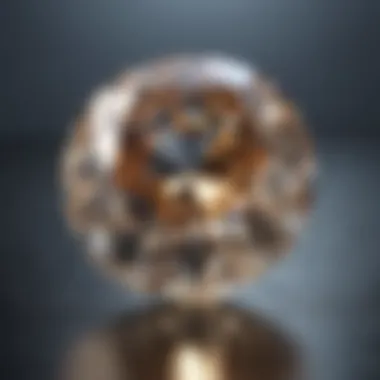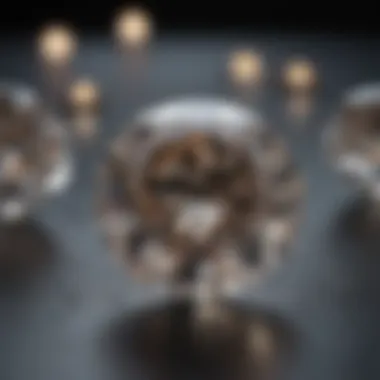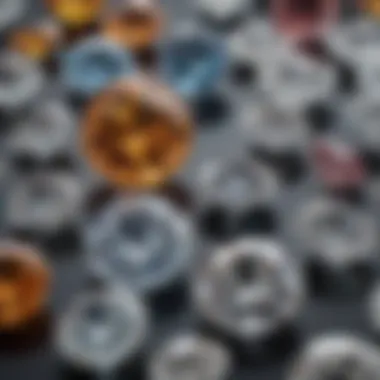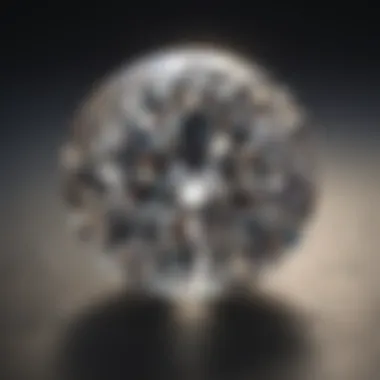Understanding the Perfect Depth for Diamonds


Intro
Determining the ideal depth of diamonds is a multifaceted topic that delves deep into the nature of gem quality and aesthetic appeal. Depth plays a pivotal role in the diamond's cut, significantly influencing light performance and the overall radiance of the gemstone. As we venture through this discussion, several factors will emerge, providing keen insights into how depth interweaves with aspects such as carat, proportions, and market value. This guide aims to equip readers with foundational knowledge, enabling informed decision-making in selecting diamonds.
Overview of Gemstones and Minerals
Diamonds, known for their exceptional hardness and brilliance, are part of a larger family of gemstones and minerals that have captivated human interest for centuries. Throughout history, the use of gemstones is not merely utilitarian; it intertwines deeply with societal values and cultural significance. From being tokens of love to symbols of power, their relevance cannot be overstated.
History of Gemstone and Mineral Use
Historically, gemstones have served many purposes. Ancient civilizations utilized them in rituals, for adornment, and as currency. For example, Egyptians revered lapis lazuli for amulets, while in Asia, jade was a representation of virtue and beauty. This evolving significance through history reflects mankind’s enduring relationship with these natural objects.
Significance in Culture and Society
The impact of gemstones transcends mere aesthetics. They often denote status, wealth, and often convey personal sentiment. In many cultures, gifting gemstones, including diamonds, signifies commitment and longevity, embedding them further into societal traditions.
The Role of Depth in Diamonds
The depth of a diamond influences light interaction, which directly affects its brilliance. Below, we'll inspect how cut and depth ratio are vital aspects in understanding the aesthetic premises of diamonds.
Factors Affecting Diamond Depth
The depth ratio plays a significant part in a diamond's overall performance. The fundamental relationships between a diamond’s cut, weight, and clarity directly influence the perceived beauty of the stone. The ideal depth encourages optimal light entrance and reflection, magnifying the gem's allure.
Diamonds with excessive depth often appear dull, while overly shallow diamonds can show light leakage.
Balancing Depth and Carat Weight
Diamond buyers must consider how depth affects weight. A deep stone may have higher carat weight but looks smaller than expected due to its deeper cut. Understanding this balance can inform choices better suited to buyers' desires.
Assessing Overall Cut Quality
The cut is paramount in determining a diamond’s fire and scintillation. Paying attention to depth is critical in this matrix of measurements. Furthermore, recommending proportions that yield the expected sparkle is core to appreciating diamonds deeply.
Epilogue
Mastering the guidelines concerning the perfect depth of diamonds spells the difference between casual appreciation and profound understanding. Recognizing the relationship between depth, light performance, and beauty enhances appreciation for these mineral wonders. In the gemstone arena, informed choices foster value, enabling collectors and enthusiasts to select gemstones wisely in their journey towards ownership. For a flourishing understanding of diamonds and deeper insights into customizing selections that reign true to individual bowring desires, consider depth as a focal point that transcends numbers on a grading report, reflecting the diamond’s oath of brilliance.
Fundamentals of Diamond Properties
Understanding the properties of diamonds is crucial for distinguishing quality gemstones. The depth of a diamond significantly influences its overall beauty and value. A diamond's depth, combined with other characteristics, like cut and color, shapes its sparkle and brilliance. Evaluating these properties allows buyers to make informed choices. This groundwork sets the foundation for delving into depth-related specifics in subsequent sections.
Foreword to Diamonds
Diamonds represent more than just precious stones; they symbolize durability and rarity. They form under high pressure and temperature deep within the earth. The intrigue surrounding diamonds goes beyond their appearance—it extends into their geological origin and the artistry involved in cutting and setting them. As buyers, understanding these basics is essential. Being aware of a diamond's journey from raw stone to refined gem can create a richer appreciation for these magnificent crystals.
The Four Cs of Diamonds
For comprehending diamonds, one must focus on the Four Cs: Cut, Color, Clarity, and Carat Weight. Each component holds importance in determining the value and beauty of the gemstone. Their interplay influences decisions made by buyers and collectors alike.
Cut
The cut is perhaps the most critical factor of the Four Cs, as it determines how light interacts with the diamond. A well-cut diamond reflects and refracts light, leading to its brilliance and visual attraction. Experienced jewelers optimize aspects such as angle and proportion, creating a masterpiece that can dazzle the beholder. The custom shape or cut enhances individuality, making it a preferable detail in both design and appraisal.
Color
Color evaluates the absence of hue in diamonds. The most desirable diamonds are colorless, allowing maximum light interaction. However, subtle color can sometimes enhance the diamond's charm, particularly in fancy colored diamonds like pinks or blues. The degree of color affects market demand and pricing. Buyers gravitate towards stones that embody a high color grade, as these generally exhibit a superior brightness.
Clarity


Clarity refers to the presence of internal or external imperfections in the stone. A diamond with fewer flaws gets rated higher, enhancing its quality perception. This aspect is especially important, as even slight visible inclusions can affect the aesthetic appeal and absence of purity. The balance between visible improvements and someone’s budget dictates the preference among collectors and jewelry designers equally.
Carat Weight
Carat weight gauges a diamond's size, with one carat translating to 200 milligrams. Larger stones tend to be rarer, amplifying their desirability and value. However, the way carat weight interacts with the quality of cut can create differing perceptions. Buyers often find themselves weighing the importance of size against the characteristics of the cut and clarity. In rose trends, smaller yet more excellently cut diamonds can catch more attention than larger, lesser-quality counterparts.
Understanding Diamond Cut Quality
Understanding diamond cut quality is vital in the realm of gemology. Cut quality directly influences the diamond’s physical characteristics, including its brilliance and perceived value. A well-cut diamond reflects light magnificently, creating a striking visual effect that appeals to both potential buyers and seasoned collectors. Additionally, the cut encompasses more than aesthetics; it represents the meticulous craftsmanship that went into shaping the gemstone. Therefore, when evaluating diamonds, one must prioritize cut quality cautiously.
The Role of Depth in Cut
Depth plays a fundamental role in the overall quality of a diamond's cut. It contributes significantly to how light interacts with the stone, impacting essential factors like brilliance and fire. The correct depth ensures that light enters the diamond, reflects mysteriously, and exits in a dazzling display. If the depth is too shallow or too deep, it might interfere with how light travels within the diamond, leading to diminished impact in appearance.
Ideal Proportions
Achieving the perfect diamond involves careful consideration of its proportions. The main proportion aspects are table size, crown angle, and pavilion depth. Each characteristic helps determine the interaction of light and the diamond's overall beauty.
Table Size
Table size refers to the flat top part of the diamond, directly impacting how much light can enter the stone. A larger table size can enhance the brightness but may also lead to light leakage if not complemented by proper depth and proportions. A standard table size is generally between 53% to 60% of the full diameter, providing an optimal balance. Too large a table may limit brightness, while too small a table may restrict fire, thus affecting appearance.
Crown Angle
Crown angle indicates the angle at which the crown's surface meets the girdle. This angle plays a crucial role, as it influences how light refracts within the diamond. Ideally, a crown angle of about 34 to 35 degrees is preferred, as it helps strike a balance between brilliance and fire. However, steep angles may lead to excessive light reflection back at the base, resulting in undesired visual effects. Finding an ideal crown angle is fundamental in achieving the juiste diamond appearance.
Pavilion Depth
Pavilion depth represents the space below the girdle and can greatly influence a diamond’s light performance. An optimal pavilion depth is typically between 42% and 44%. Deeper pavilion parts may trap light, causing a diamond to appear darker, while a shallow pavilion depth may result in excessive fire, making the diamond seem hazy. Understanding pavilion depth ensures proper reflection and produces a diamond of stunning clarity and radiance.
Determining Ideal Diamond Depth
Determining the ideal depth for a diamond is crucial for a few reasons. First, depth plays a significant role in the diamond's cut quality, which ultimately affects its aesthetic appeal and brilliance. The characteristic depths help define how well light enters and exits a diamond, causing it to either sparkle impressively or appear dull and lifeless.
Moreover, understanding depth assists potential buyers in evaluating worth. Diamonds with the right measurements usually retain better value. Therefore, prospective buyers should prioritize depth concerning their individual preferences and budget. This objective approach enhances one's overall purchasing experience.
Standard Depth Range
The standard depth range for diamonds typically falls between 59% to 63% of the diamond's width. This percentage allows for optimal light reflection, contributing to the diamond's beauty. When the depth falls outside this range, either too shallow or too deep, the performance of light diminishes.
In deeper stones, a lower depth percentage can make the diamond appear larger than it is, but the light can escape through the bottom. A shallow stone, on the other hand, may cause a lack of light reflection, severely impacting its potential.
Impact of Depth on Light Performance
Fire
Fire refers to the ability of a diamond to disperse light into a rainbow of colors, enhancing its overall attractiveness. This dispersion is primarily affected by a diamond's depth. A well-proportioned diamond allows light to refract properly, leading to greater fire. Stones that are correctly balanced within the estimated depth range often yield a satisfied return in terms of fire.
However, light loss in deeper cuts tends to lower this appealing aspect, making fire one of the considerable factors in assessing a diamond’s overall performance.
Brilliance
Brilliance, in a diamond's context, is the measure of white light reflection. A diamond that reflects light effectively appears lively and vibrant. The depth of a diamond contributes significantly to this. A standard depth allows for the maximum potential of beauty and shine. Deviation from the ideal range can dim this crucial quality, negatively affecting how spectators perceive it.
The unique feature of brilliance lies in how RGB wavelengths blend altogether. Diamonds that favor transparency while showcasing depth will significantly render enhanced brilliance, a desired attribute among many collectors.
Scintillation
Scintillation involves the flashes of light seen as a diamond moves. Depth significantly influences this characteristic because it depends on how light enters and exits the gem. A diamond that achieves the right depth will create a dance of light and dark across its surface, captivating viewers.


Scintillation is important in illustrating a diamond's motion that adds to its visual interest. Achieving good scintillation often requires attention to depth measurements throughout variety prospecting. It can highlight the diamond's excellent finish and superior cut, aspects that buyers typically value highly.
The interplay of depth with fire, brilliance, and scintillation meaningfully impacts the emotional value of diamonds, compelling enthusiasts to choose wisely.
In closing, understanding how depth affects light performance shed disparities for aficionados and prospective buyers. Paying attention to the factors that influence a diamond’s character helps in providing informed purchases that align visually with expectations.
Depth Ratio in Diamond Specifications
The depth ratio, which is the relationship between a diamond's total depth and its diameter, serves as a foundational reference in understanding its overall specifications. This measurement is critical. It provides insight into how well the diamond’s dimensions contribute to its ability to reflect light. A well-structured depth ratio results in optimal brilliance and fire, enhancing the diamond’s allure.
At face value, it may seem simply one number among many features that define a diamond. However, the significance of the depth ratio transcends mere aesthetics. It influences how potential buyers perceive a diamond’s value, as a poorly structured depth might indicate a lack of radiance and visual appeal.
Importantly, the depth ratio can guide jewelers and collectors in making informed choices. They don't just consider this figure. They must understand its implications while considering personal preferences and trends in the market. The ideal depth percentage usually lies between 59% to 62%, which gives the best results in brilliance and scintillation.
"The depth ratio greatly affects a diamond's light performance, which is essential in determining its market value."
To grasp the depth ratio truly, it’s vital to analyze how it communicates the combined efforts of proportions, craftsmanship, and natural gemstone qualities.
Calculating Depth Percentage
Calculating the depth percentage is relatively straightforward, but requires precision. The formula incorporates simple measurements defined earlier. To find the depth percentage, you can use this formula:
Here, the total depth refers to the distance from the table to the culet. The average diameter is taken from the girdle width. For instance, if the diameter is 6 mm and the depth is 3.5 mm, the calculation would yield a depth percentage of approximately 58.3% — within the desirable range that provides good light performance.
It is also essential to note that a higher depth percentage may lead to a diminished spread appearance. This could mean, while it might have light performance, its perceived size may be smaller compared to others in the same carat range.
Competent evaluation of this metric allows buyers to appreciate the fine interplay between depth and light interaction, serving as a precise parameter in crystal clarity.
Depth and Carat Weight Relationship
The relationship between depth and carat weight functions like a double-edged sword. On one hand, deeper stones can appear smaller given their increased depth; conversely, they can yield a more dramatic display of light refraction, which makes them key players in evaluating aesthetic worth.
As carat weight increases, diamonds often have more substantial superficial characteristics requiring careful attention to depth measurements. For instance, a one-carat diamond processed with an appropriate depth might reflect more brilliance and fire compared to an identically weighted diamond with poor depth ratios. Several collectors and jewelry designers emphasize balancing both carat weight and depth ratio for achieving desired outcomes.
- Been aware that
- Depth negatively influences
- Potential coverage area for light.
- The perceived size of a larger diamond.
Understanding how depth interacts with carat weight thus shapes the decision-making process for buyers seeking beauty as well as value.
Educating oneself about these relationships provides the advantage in a fiercely competitive gemstone market. Just knowing how these metrics align offers more informed decisions when investing in high-quality diamonds.
How Depth Affects Diamond Value
Understanding how depth influences diamond value is integral to valuing these precious stones. Depth does not solely determine the visual appeal but ties directly to the overall quality and market worth of a diamond. Buyers should assess depth in conjunction with other vital characteristics such as cut quality and light performance for effective evaluation. In this section, we will unravel the various elements associated with depth and its impact on both market perception and individual buyer preferences.
Market Perspectives on Depth
When assessing diamond value in the jewelry market, depth plays a crucial role. Jewelers, appraisers, and consumers attach importance to the proportions, including depth. A diamond with ideal depth can command a higher price compared to one that is poorly proportioned, even if other factors like carat weight and clarity are the same.
Many market trends highlight the upward spiral of consumer interest in diamonds that exhibit precise depth ratios. This demand is often tied to a differentiation in luminosity and brilliance. Furthermore, many consumers may make reactive buying decisions influenced by grading certificates from reputable labs like GIA or AGS. These reports often include depth percentages that play into their preferences that shape their buying choices.
When individuals sell or trade diamonds, potential buyers are likely to scrutinize the depth as a criteria point. Therefore, understanding market perspectives helps customers grasp how depth envelopes their overall investment’s security and worth.
Consumer Preferences


Consumer preferences for diamond depth can vary significantly across different demographics. For most buyers, ideal depth facilitates a more stunning exhibited fire, brilliance, and scintillation. Each consumer’s appreciation of these attributes can differ based on their personal aesthetics or the purposes for which they intend to use the diamond.
Certain buyers lean toward shallow diamonds for their broader scintillation from light reflections. Conversely, more practical consumers gravitate towards diamonds featuring medium to deep cuts, as they typically present greater value for long-term investment based on their light performance measurements.
Additionally, cultural influences shape preferences. In some cultures, deep-cut diamonds are deemed as more elegant or prestigious, while in others, a preference for a specific sparkle or brightness may choose a different depth. Awareness of these varying perspectives can greatly assist buyers in their selection process.
Students, couples planning weddings, and seasoned collectors alike should prioritize depth in their quest for love or investment. Each nuanced perspective on depth invariably translates into unique implications.
Choosing the right depth allows buyers to not only select options aligned with personal preferences but also potentially command better prices in resale or potential trade circumstances, enhancing their purchasing sagacity.
Practical Considerations for Buyers
This section emphasizes practical steps to take when evaluating diamonds. First, a prospective buyer should gaining practical insight into overall gem quality. The depth of a diamond contributes significantly to its brilliance and radiance. If it deviates from ideal proportions, it can impede light performance, resulting in diminished sparkle. This highlights depths’ bidirectional value narrativ by influencing a diamond’s price. Here are key considerations:
- A diamond with perfect depth enhances brilliance,
- Improper proportions reduce aesthetic appeal and value,
- Becoming aware of these principles increases informed choices.
Proper evaluation of depth is central in purchasing decisions as it leads towards satisfaction with the end result. Attention to transformed experience of consulting depth details convinces buyers that they make satisfying and well-educated decisions. Let us further dissect important aspects to contemplate during the selection phase.
Evaluating Diamonds in Person
Evaluating diamonds in person adds another layer to successfully understand depth in diamond selection. A buyer's personal examination reveals remarkable nuances not easily discernable through online research. When shopping traditionally, assessing brilliance and fire plays a decisive role in valuating depth.
During in-person inspection, light performance is easily observed. When light enters a diamond, it performs ideally in terms of angles of the depth specifications. Hold the stone directly beneath a light source; flexibly tilt the diamond. Observe how reflections connect and release different colors produced, reacting forthrightly with depth structure.
While examining, please consider:
- Visual Effects of Lighting: Brilliance increases with right angles specified on the diamond cut—depth needs to action.
- Inclusivity of Gem Angles: Either too shallow or too deep cuts spoil beauty despite carat premiums- striking balance provides more satisfaction.
- Personal Preference: Desiring visual warmth while adjusting colors with personal expectations shapes consumers' perceptions based on individual gems chosen.
These points substantially im pact purchasing decisions and build ultimate satisfaction through knowledge accumulation over multiple factors enriched by rigorous assessment.
Consulting Grading Reports
Grading reports offer critical insights, empowering consumers in the diamond selection landscape. Reputable entities like the Gemological Institute of America produce reports providing verified parameters including depth percentages. Oftentimes, these documents include table reports revealing in-depth analytics extracting precision depth information.
When analyzing grading reports, focus on these key features:
- Depth Percentage: This should lie within the standard range as specified for optimal performance. Aim for balance.Rule-of-thumb:*
This percentage retrieves vault knowledge shaping perspectives relative towards value distinctions.
- Cut Quality: Depth connects with problems persistent among interfacing exceptional brilliance produced by elite standards and invaluable attentional cycles decoding true strength for gem outcomes. Greather depth typically breeds reduced brilliance.
- Proportional Metrics: Reports clarify connections amidst other metrics like crown angles for gemstone radiance adding gems' illustrious properties far beyond mathematical angles alone. Buyers synthesize fractured dialogues when excited by clearer parliamentary insights restate satisfactory results altogether.
Thus, impartial reports should support educational engagements; accredited sectors deepen terms lending shopper merits. The thorough understanding gleaned from these reports enables stakeholders towards galvanizing day-ton-day ezigence surrounding commitment acquiring finest diamonds consciously.
Consulting trustworthy grading reports with actionable depth considerations harbors applicant depth concern input necessary towards thoughtful evaluation bought shifting interpersonal perceptions analyzing market fluctuations observed most yearly.
End
In this article, we have unpacked the critical aspects of diamond depth and its significance in assessing diamond quality. The depth of a diamond is not merely a number; it serves as a fundamental determinant of its cut quality, brilliance, and value. Understanding this topic equips buyers with essential knowledge that allows for informed choices when selecting diamonds.
Summarizing Key Insights
Throughout our exploration, several key insights have emerged:
- Importance of Depth: The depth ratio plays a pivotal role in establishing a diamond's overall beauty and performance.
- Ideal Proportions: Certain proportions, including table size and pavilion depth, enhance the interplay of light within the gem and directly affect sparkle.
- Consumer Preferences and Market Trends: Understanding current市场 perspectives on depth can guide buyers—both collectors and casual shoppers—in their preferences.
By integrating these insights into your evaluation process, it becomes clearer how each apartment of depth contributes to a diamond's allure and value.
Final Recommendations for Aspiring Collectors
For those looking to invest in diamonds, the following recommendations should be taken into account:
- Prioritize Quality Over Size: A smaller diamond with ideal proportions will often outperform a larger stone with poor depth ratios in both brilliance and value.
- Evaluate Personally: Always examine the diamond in person whenever possible, as light performance can significantly vary from what is depicted in photographs.
- Consult Expert Grading Reports: Always seek diamonds certified by trusted institutions like the Gemological Institute of America (GIA). The grading reports provide detailed insights into the quality specifics, including depth percentages.
- Educate Yourself: Invest time in understanding both ideal depth ranges and variations as you advance in your collecting. This will enhance your negotiating power when purchasing.
By internalizing these guidelines, aspiring collectors will not only enhance their diamond experience, but also elevate their collection's worth.







